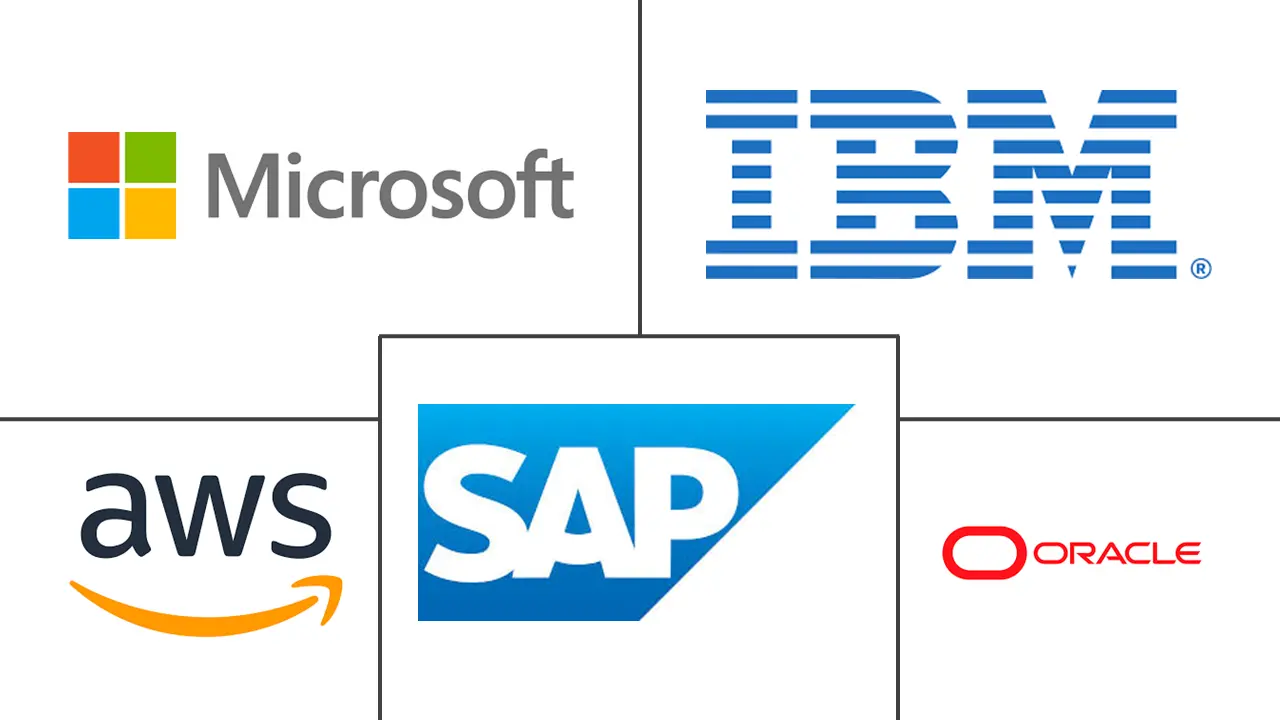Streaming Analytics Market Size and Share
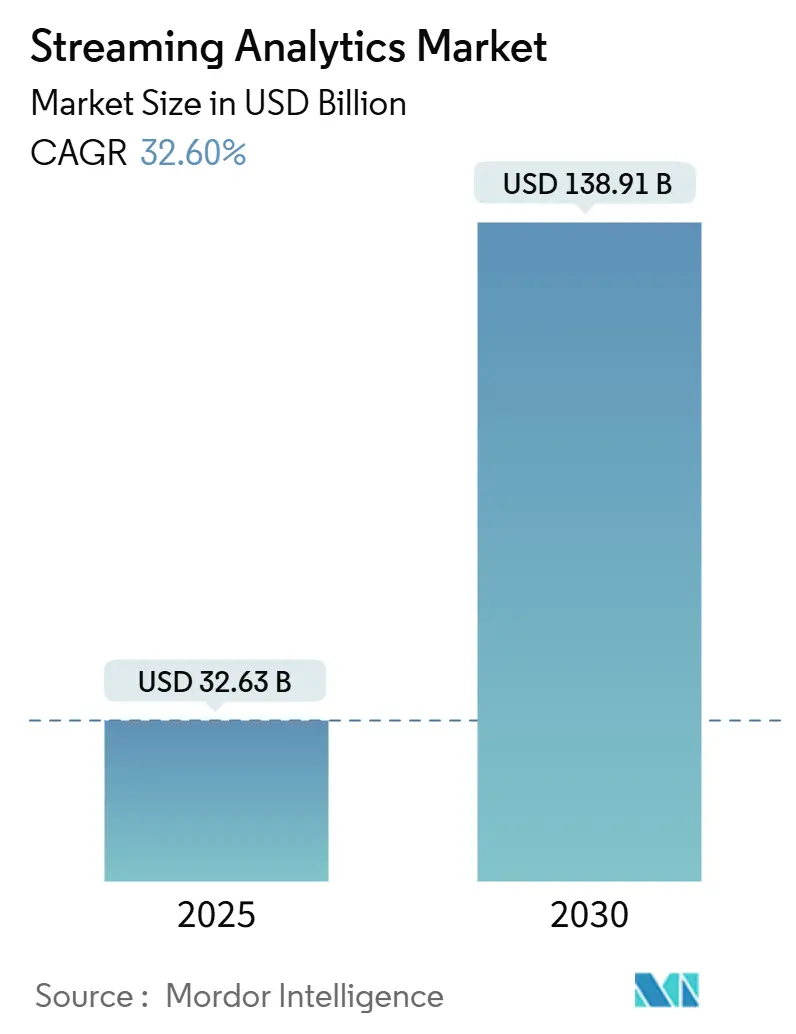
Streaming Analytics Market Analysis by Mordor Intelligence
The streaming analytics market is valued at USD 32.63 billion in 2025 and is forecast to reach USD 138.91 billion by 2030, advancing at a 33.6% CAGR. Near-instant insights generated from continuously flowing data are becoming a board-room priority as enterprises pivot away from batch practices toward responsive, AI-enhanced decision loops. Generative models embedded directly inside data pipelines, wide availability of edge inference chips, and a growing set of managed cloud services collectively compress the time between data capture and action. Vendors are refining pay-as-you-go pricing and simplifying orchestration so that firms can scale real-time workloads without provisioning burdens. While early adopters focused on fraud detection and recommendation engines, 2025 sees an uptick in industrial reliability use cases, telehealth monitoring, and 5G-enabled network optimization. Heightened sensitivity to data-transfer charges and talent scarcity temper otherwise robust demand, yet the fundamental shift toward event-driven architectures keeps the streaming analytics market on a steep growth path.
Key Report Takeaways
- By component, solutions accounted for 65.4% revenue in 2024, whereas services are expanding at 33.8% CAGR through 2030.
- By deployment, cloud recorded 59.5% of the streaming analytics market share in 2024 and is growing at 34.2% CAGR to 2030.
- By end-user industry, media and entertainment led with 35.8% revenue share in 2024; it is also the fastest-growing segment at 34.5% CAGR.
- By organization size, large enterprises held 63.2% share of the streaming analytics market size in 2024, yet SMEs post the highest CAGR of 33.7%.
- By geography, North America held 29.7% share of the streaming analytics market size in 2024, yet Asia-Pacific post the highest CAGR of 34.1%.
Global Streaming Analytics Market Trends and Insights
Drivers Impact Analysis
| Driver | (~) % Impact on CAGR Forecast | Geographic Relevance | Impact Timeline |
|---|---|---|---|
| Generative-AI infused data pipelines | +8.2% | Global, with early adoption in North America and Asia-Pacific | Medium term (2-4 years) |
| Edge AI chips enabling on-device stream processing | +6.8% | APAC core, spill-over to North America and EU | Long term (≥ 4 years) |
| Low-code/no-code streaming workbenches for citizen developers | +4.3% | Global, particularly strong in SME segments | Short term (≤ 2 years) |
| Mainstream adoption of event-driven micro-services | +5.1% | North America and EU, expanding to Asia-Pacific | Medium term (2-4 years) |
| Growing SME demand for cloud stream analytics | +3.8% | Global, led by North America and Europe | Short term (≤ 2 years) |
| Expansion of IoT and industrial automation | +4.9% | Global, with manufacturing hubs in Asia-Pacific leading | Long term (≥ 4 years) |
| Source: Mordor Intelligence | |||
Generative-AI Infused Data Pipelines
Context-aware models integrated with high-throughput brokers turn raw events into prescriptive actions in milliseconds. Financial institutions combining language models with streaming telemetry report 40% gains in fraud-detection accuracy while slashing false positives.[1]Confluent,“Confluent and Databricks Deepen Partnership,” Confluent Blog, confluent.io Bidirectional connectors between Confluent Tableflow and Databricks Delta Lake keep models supplied with fresh, lineage-rich data, eliminating manual refresh cycles. Retailers now auto-tune promotion parameters in real time, lifting conversion rates during flash sales. As libraries for vector search and semantic enrichment join core stream engines, predictive maintenance and anomaly triage are shifting from dashboards to closed-loop autonomy. The result is a broader enterprise appetite to operationalize AI without the latency penalties of traditional ETL.
Edge AI Chips Enabling On-Device Processing
NVIDIA’s Jetson AGX Thor supplies up to 8 times the prior-generation compute, with 128 GB memory supporting hefty transformer inference at source.[2]NVIDIA“Introducing NVIDIA Jetson AGX Thor,” NVIDIA Newsroom, nvidia.com Manufacturers deploy the module next to vibration sensors so that models flag bearing wear before costly downtime. Hospitals rely on edge inference to trigger nurse alerts when patient vitals deviate, meeting privacy rules that restrict continuous cloud upload . Emerging accelerators like Groq’s LPU push token generation to 300 tokens per second, letting conversational assistants run inside teller kiosks. By sidestepping back-haul latency and bandwidth charges, firms unlock real-time use cases in ships, mines, and rural cell towers where connectivity remains inconsistent. The technology thus widens geographic reach for the streaming analytics market while reinforcing compliance with data-sovereignty codes.
Low-Code/No-Code Streaming Workbenches for Citizen Developers
Drag-and-drop canvases hide the complexity of partitions, watermarking, and schema evolution, letting domain experts assemble flows without Java or Scala. TrendMiner shows plant operators configuring predictive-maintenance models in weeks instead of quarters.[3]TrendMiner, “TrendMiner Empowers Plant Operators with No-Code Analytics,” trendminer.com OutSystems integrates Confluent infrastructures so that finance analysts stream card-swipe data into risk dashboards without IT backlog. This democratization is crucial for SMEs that cannot compete for scarce Kafka talent. Visual abstractions also accelerate experimentation, allowing marketing teams to A/B-test personalization rules on live clickstreams swiftly. Easier tooling, therefore, reduces the barrier to entry and expands the addressable streaming analytics market.
Mainstream Adoption of Event-Driven Micro-Services
Digital natives dismantle monoliths so that each service responds to Kafka or Pulsar topics, scaling precisely with demand. Uber processes advertising events using Apache Flink with exactly-once guarantees, ensuring billing accuracy at multi-million-TPS rates. DoorDash ingests millions of delivery events per second, updating routes and surge pricing in near real time. With services decoupled, failures stay local and new features deploy without full-stack releases, lifting developer velocity. Enterprises previously tied to nightly batch jobs now re-platform CRMs, ERPs, and MES systems onto event streams, embedding analytics directly into transactions. As architecture blueprints mature, board-level risk aversion declines, further elevating the streaming analytics market trajectory.
Restraints Impact Analysis
| Restraint | (~) % Impact on CAGR Forecast | Geographic Relevance | Impact Timeline |
|---|---|---|---|
| Rising Kafka skill-set shortage and wage inflation | -4.7% | Global, particularly acute in North America and EU | Short term (≤ 2 years) |
| Escalating egress fees on hyperscaler clouds | -3.2% | Global, affecting multi-cloud strategies | Medium term (2-4 years) |
| Data-sovereignty regulations limiting cross-border stream flows | -2.8% | EU leading, expanding to Asia-Pacific and Americas | Long term (≥ 4 years) |
| Legacy batch-centric architectures delaying migration | -3.9% | Global, particularly in traditional enterprises | Medium term (2-4 years) |
| Source: Mordor Intelligence | |||
Rising Kafka Skill-Set Shortage and Wage Inflation
Eighty-plus percent of Fortune 100 enterprises rely on Kafka, yet job boards list far more openings than qualified engineers. United States salaries top USD 100,000, squeezing budgets for mid-tier firms. The steep learning curve around brokers, replication factors, and exactly-once semantics deters newcomers, while retaining talent proves challenging as cloud vendors poach senior staff. Managed platforms help but trade flexibility for subscription outlays. Consulting partners expand training bootcamps, though ramp-up times still lag project deadlines. Until educational pipelines catch up, talent scarcity will curb some rollouts, particularly in regulated sectors where outsourcing is constrained.
Escalating Egress Fees on Hyperscaler Clouds
Data-transfer charges can consume 10–15% of real-time-processing budgets, and surprise spikes emerge during traffic bursts. ClickHouse Cloud’s price list revision in January 2025 added new egress tiers, prompting customer protests. Although Google waived exit fees for bulk migrations, inter-region transit and multi-cloud replication still incur costs. Architects now compress, deduplicate, and sample streams to control spend, but each tactic erodes analytical granularity. Organizations with strict latency SLAs hesitate to bifurcate workloads, strengthening provider lock-in and narrowing vendor negotiation leverage. Cost opacity therefore restrains optimal architecture design and slows certain expansions within the streaming analytics market.
Segment Analysis
By Component: Services Expand as Real-Time Complexity Grows
Solutions provided the structural backbone of the streaming analytics market in 2024 with 65.4% revenue, reflecting wide adoption of brokers, processors, and interactive query engines. Yet services are accelerating at 33.8% CAGR through 2030 as enterprises seek design blueprints, migration aid, and 24/7 SRE support. Architecture assessments, data-quality remediation, and schema governance dominate new statements of work. Confluent and EY formed a strategic alliance in 2025 to bundle implementation accelerators, underscoring demand for outside expertise. As observability and cost-optimization mandates rise, managed services extend from simple hosting to auto-tuning capacity based on event velocity.
Skills shortages push even risk-averse sectors to outsource runtime operations, shifting budgets from capital expenditure to recurring services. Vendor roadmaps show pre-packaged compliance modules for PCI-DSS and HIPAA emerging inside subscription tiers, which lowers the barrier for regulated adopters. Consequently, the streaming analytics market size for professional and managed services is projected to outpace core software revenues, reinforcing a virtuous cycle where know-how, not tool count, differentiates providers.
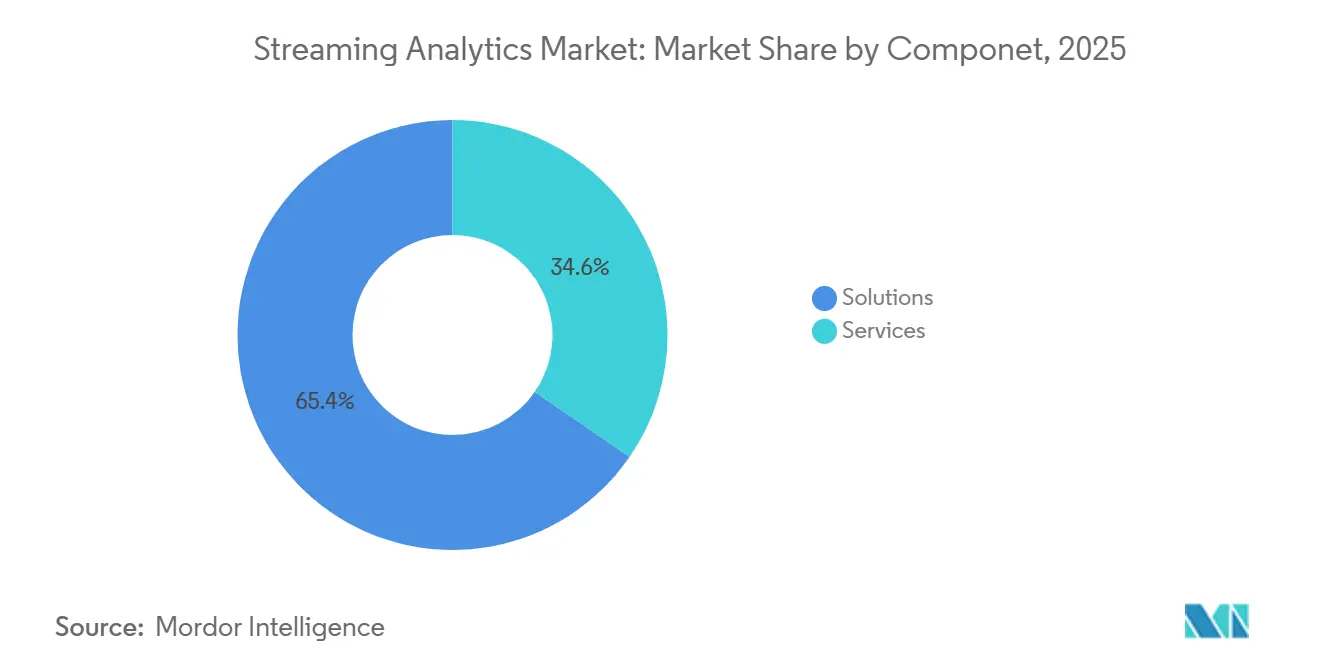
By Deployment: Cloud Dominance Shapes Sourcing Strategy
Cloud claimed 59.5% of 2024 revenue, and its 34.2% CAGR signals continued preference for elastic capacity. Hyperscalers pair auto-scaling stream engines with lakehouses and vector databases, letting teams ingest, enrich, and serve ML features without hardware procurement. Google Cloud stitches Pub/Sub, Dataflow, BigQuery, and Vertex AI into a managed continuum, easing burden for firms lacking distributed-systems talent. The streaming analytics market size for on-premise workloads remains meaningful in defense, fintech, and public health, but growth trails cloud due to refresh cycles and capex hurdles.
Hybrid blueprints mitigate egress costs by processing sensitive telemetry in factories with Azure SQL Edge before forwarding aggregates to cloud ML endpoints. Providers now enable policy-based topic placement so that individual partitions stay inside national borders, satisfying emerging sovereignty rules. Over the forecast, multicloud federation tools that span IAM, lineage, and governance will influence vendor selection as buyers seek exit-cost protection.
By End-User Industry: Media and Entertainment Tops Adoption Curve
Media and entertainment led revenue in 2024 at 35.8% and retains the fastest 34.5% CAGR. Streaming platforms process concurrent viewing telemetry to personalize thumbnails, prefetch bandwidth, and price ad slots in sub-second windows. Disney+ Hotstar deploys Kafka and Flink clusters to accommodate cricket viewership peaks exceeding 45 million simultaneous users. Retail and e-commerce trail closely, ingesting clickstream, inventory, and payment signals to synchronize stock and prevent fraud. Manufacturing embraces predictive maintenance by analyzing vibration and temperature feeds, while BFSI focuses on anti-money-laundering and market-risk engines that demand deterministic latency.
Healthcare providers adopt real-time vitals monitoring, forwarding edge-filtered alerts to clinicians for intervention. Transportation and logistics operators employ geospatial streaming to optimize driver routes and cold-chain integrity. Telecommunications carriers apply AI models to 5G core metrics for congestion prediction. Across verticals, sector-specific accelerators—such as fraud-rules templates or asset-health schemas—further widen the streaming analytics market.
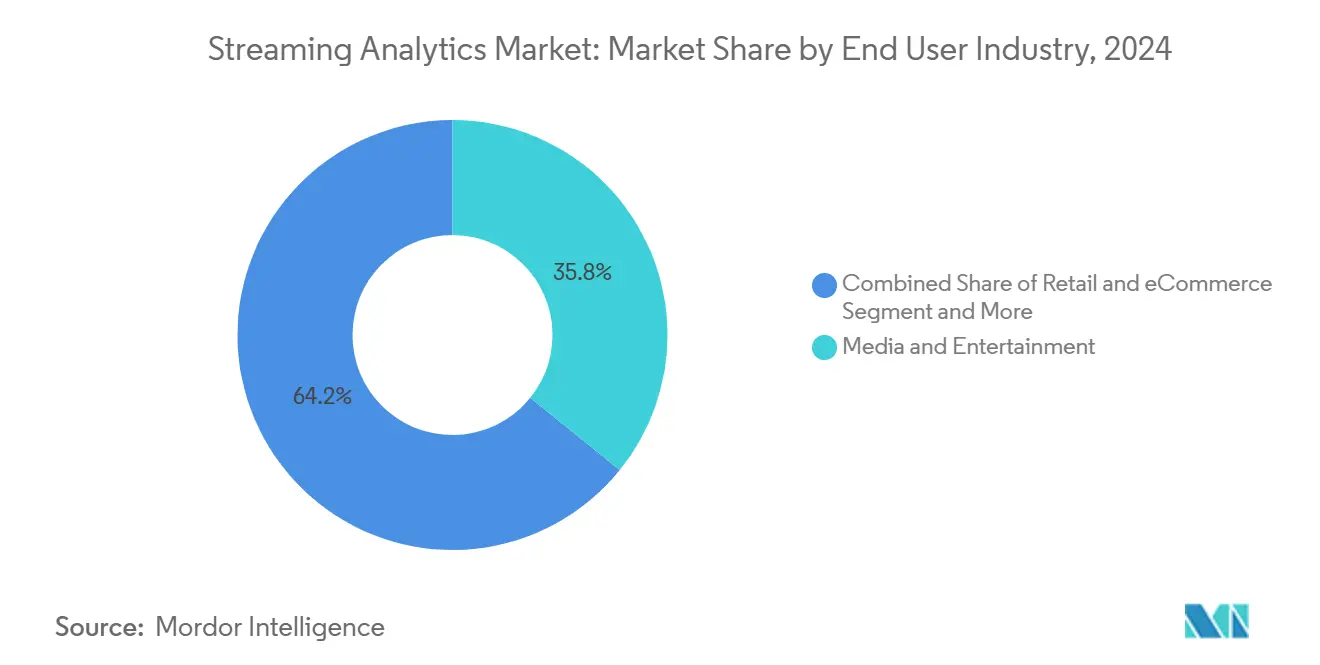
Note: Segment shares of all individual segments available upon report purchase
By Organization Size: SMEs Narrow the Real-Time Divide
Large enterprises accounted for 63.2% of 2024 revenue, leveraging deep pockets to self-host petabyte-scale clusters and integrate bespoke micro-services. However, SMEs exhibit a 33.7% CAGR as managed cloud and low-code tooling remove heavy upfront investments. Pay-as-you-stream meters mean smaller shops can pilot projects on day-one data volumes, then auto-scale as business expands. Open-source compatibles such as Redpanda Cloud lure budget-conscious firms with simplified ops and predictable billing.
Low-code canvases let marketing or plant staff wire together CDC connectors, CEP operators, and dashboard sinks without SQL. Vendor marketplaces now bundle off-the-shelf fraud modules or IoT anomaly detectors purchasable by credit card. This democratization ensures that the streaming analytics industry no longer mirrors company size but rather digital ambition. Consequently, mid-market adoption propels diversification of service packaging and paves the way for industry-specific starter kits.
Geography Analysis
North America captured 29.7% revenue in 2024 owing to early hyperscaler ecosystems and a mature cadre of Kafka specialists. Financial services, ride-hailing, and retail pioneers validated ROI, creating reference designs that spread across sectors. Yet saturation tempers incremental growth, and skilled-labor bottlenecks spark wage premiums that influence deployment budgets. Government push for real-time public-sector dashboards—covering weather, wildfire, and mobility—adds steady demand, albeit at rigorous compliance levels.
Asia-Pacific posts the swiftest 34.1% CAGR as 5G rollouts, smart-factory programs, and sovereign cloud initiatives converge. China’s AI revenue projections near USD 300 billion by 2030, with edge streaming deemed vital to autonomous manufacturing cells. India’s public-digital-infrastructure drive embeds event streams into tax, identity, and payments rails, while Southeast Asian e-commerce platforms rely on real-time personalization to compete for mobile users. Local chipmakers and telcos co-innovate, reducing hardware costs and boosting regional vendor ecosystems, which keeps adoption momentum high.
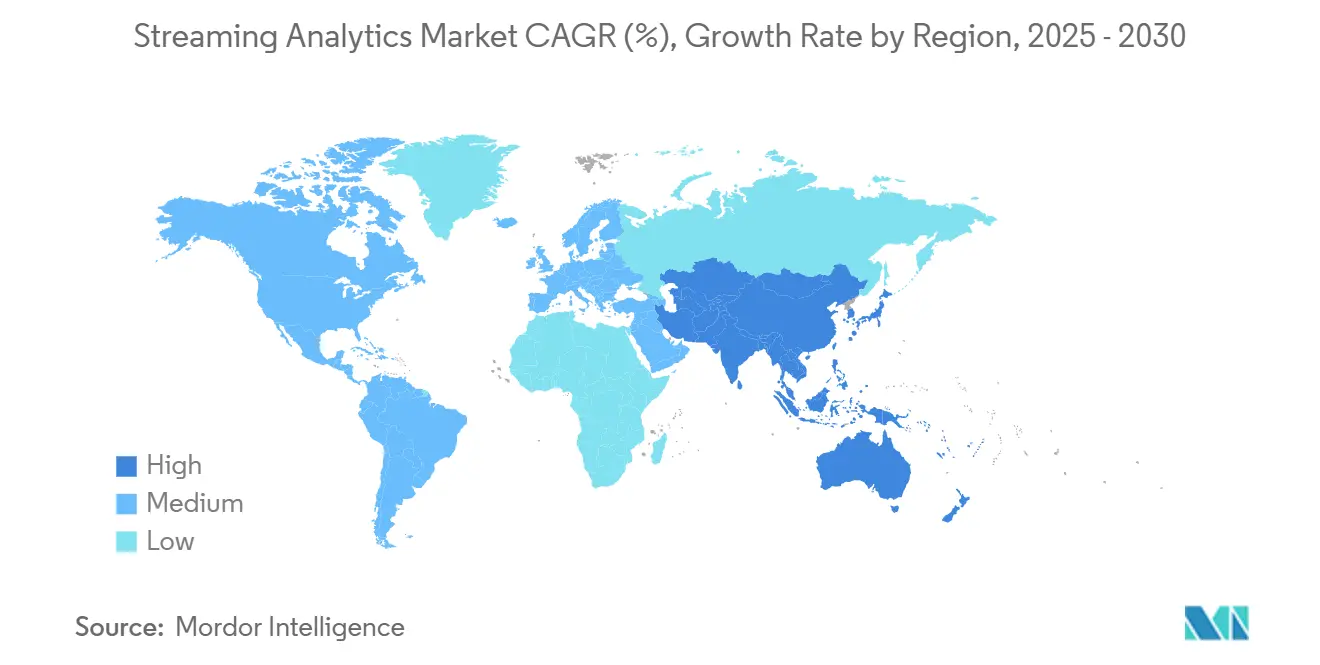
Competitive Landscape
The streaming analytics market remains moderately fragmented. Confluent, Snowflake, Databricks, Amazon Web Services, Google Cloud, Microsoft, and IBM anchor platform offerings, while specialists such as Redpanda, StarTree, and ClickHouse pursue performance or cost niches. Open-source engines—Kafka, Flink, Pulsar—continue to influence RFP decisions, yet the shift to managed services configures competition around operational simplicity.
Acquisitions accelerate capability bundling: Confluent absorbed WarpStream for serverless ingestion, IBM bought StreamSets for hybrid integration, and Qlik integrated Upsolver to widen lakehouse ingestion. Snowflake’s proposed USD 1.5 billion Redpanda deal aims to converge streaming with the data-cloud model. Strategic alliances emerge in parallel; EY’s 2025 pact with Confluent melds consulting reach with a managed platform to target brown-field modernization.
Streaming Analytics Industry Leaders
-
IBM Corporation
-
Microsoft Corporation
-
Oracle Corporation
-
SAP SE
-
Amazon Web Services
- *Disclaimer: Major Players sorted in no particular order
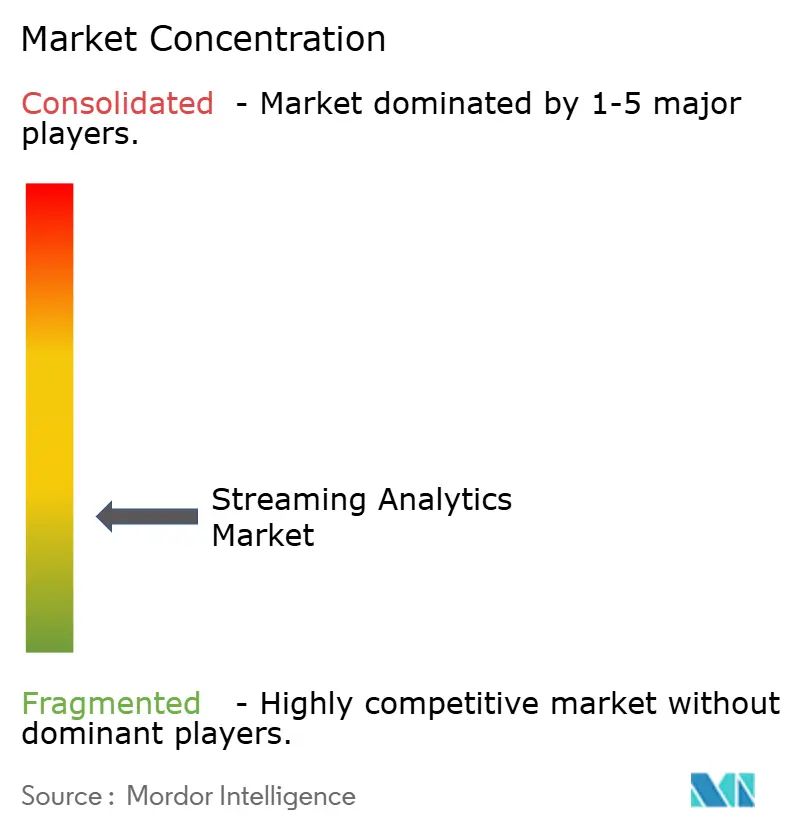
Recent Industry Developments
- June 2025: Databricks reports USD 3.7 billion annualized revenue run rate, underscoring combined streaming-and-AI demand.
- May 2025: Fivetran agrees to acquire Census to expand end-to-end real-time data activation capabilities.
- April 2025: EY forms strategic alliance with Confluent to accelerate data-stream adoption for global enterprises.
- March 2025: NVIDIA launches Jetson AGX Thor with 8× performance and 128 GB RAM for edge inference workloads.
Global Streaming Analytics Market Report Scope
Streaming Analytics allows the organizations in the setting up of real-time analytics computations on data streaming from devices, websites, sensors, social media, applications and many more. it also provides language integration for intuitive specifications along with quick and appropriate time-sensitive processing. The scope includes Type of streaming analytics as Software and Services and Deployment modes of streaming analytics such as Cloud and on-premise.
| Software |
| Services |
| On-Premise |
| Cloud-Based |
| Media and Entertainment |
| Retail and eCommerce |
| Manufacturing |
| BFSI |
| Healthcare and Life Sciences |
| Transportation and Logistics |
| Telecommunications |
| Others |
| Large Enterprises |
| Small and Medium Enterprises |
| North America | United States | |
| Canada | ||
| Mexico | ||
| South America | Brazil | |
| Argentina | ||
| Rest of South America | ||
| Europe | Germany | |
| United Kingdom | ||
| France | ||
| Netherlands | ||
| Rest of Europe | ||
| Asia-Pacific | China | |
| Japan | ||
| India | ||
| South Korea | ||
| Australia and New Zealand | ||
| Rest of Asia-Pacific | ||
| Middle East and Africa | Middle East | United Arab Emirates |
| Saudi Arabia | ||
| Turkey | ||
| Rest of Middle East | ||
| Africa | South Africa | |
| Nigeria | ||
| Rest of Africa | ||
| By Component | Software | ||
| Services | |||
| By Deployment | On-Premise | ||
| Cloud-Based | |||
| By End-user Industry | Media and Entertainment | ||
| Retail and eCommerce | |||
| Manufacturing | |||
| BFSI | |||
| Healthcare and Life Sciences | |||
| Transportation and Logistics | |||
| Telecommunications | |||
| Others | |||
| By Organization Size | Large Enterprises | ||
| Small and Medium Enterprises | |||
| By Geography | North America | United States | |
| Canada | |||
| Mexico | |||
| South America | Brazil | ||
| Argentina | |||
| Rest of South America | |||
| Europe | Germany | ||
| United Kingdom | |||
| France | |||
| Netherlands | |||
| Rest of Europe | |||
| Asia-Pacific | China | ||
| Japan | |||
| India | |||
| South Korea | |||
| Australia and New Zealand | |||
| Rest of Asia-Pacific | |||
| Middle East and Africa | Middle East | United Arab Emirates | |
| Saudi Arabia | |||
| Turkey | |||
| Rest of Middle East | |||
| Africa | South Africa | ||
| Nigeria | |||
| Rest of Africa | |||
Key Questions Answered in the Report
What is the current size of the streaming analytics market?
The streaming analytics market stands at USD 32.63 billion in 2025 and is projected to reach USD 138.91 billion by 2030.
Which deployment model is growing fastest?
Cloud deployment leads with a 34.2% CAGR because managed services simplify scaling and maintenance compared with on-premise options.
Why is media and entertainment the largest end-user segment?
Streaming platforms rely on real-time viewer telemetry to personalize content and price ads, driving a 35.8% revenue share in 2024 and a 34.5% CAGR through 2030.
What are the top growth drivers for streaming analytics?
Generative-AI-infused pipelines, high-performance edge chips, low-code workbenches, and event-driven architectures collectively add more than 24% to forecast CAGR.
Page last updated on:
